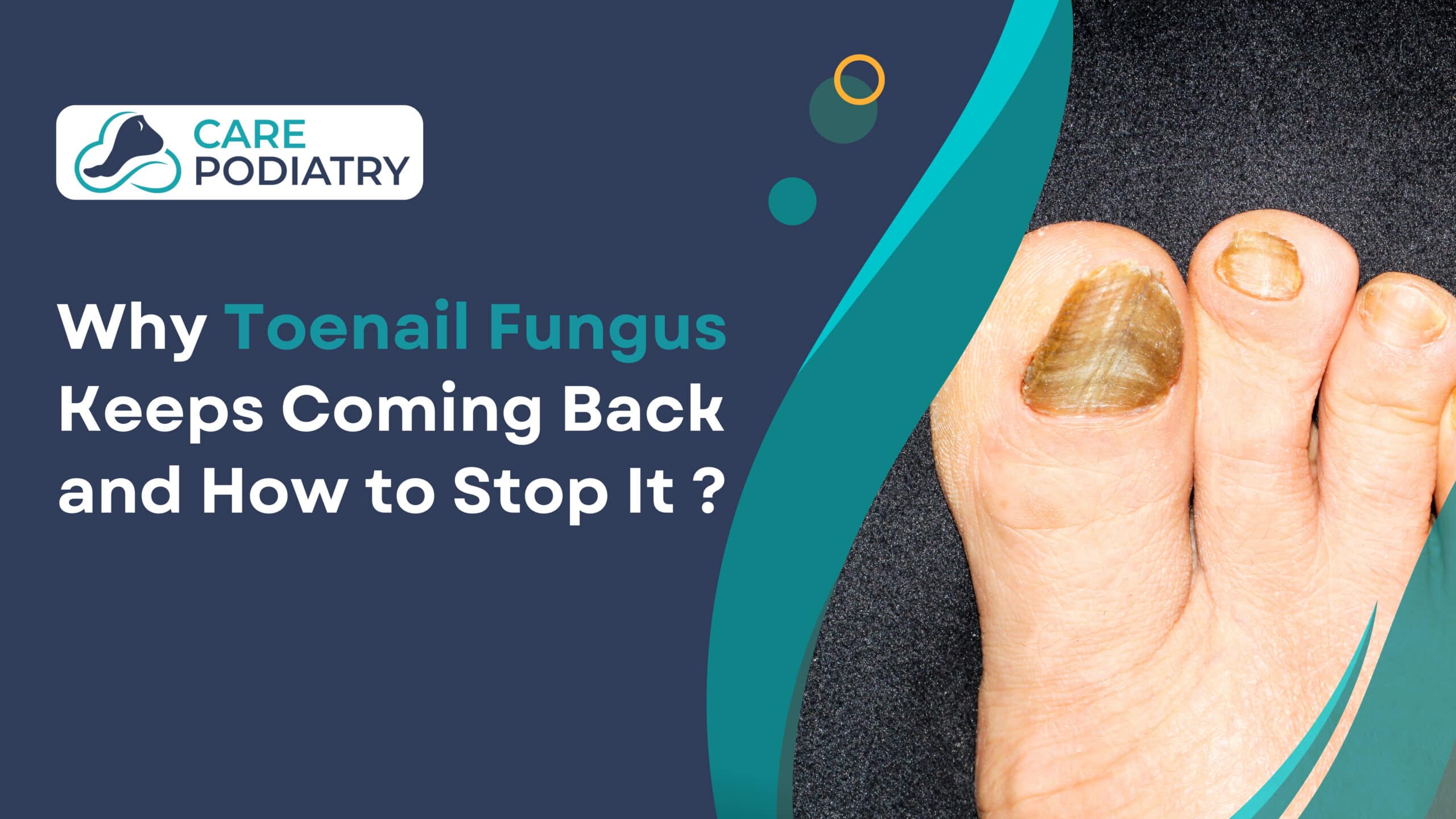Toenail fungus isn’t just annoying, it’s stubborn. Just when you think it’s gone, it comes back, often worse than before. Many patients walk into Care Podiatry in Cerritos and Lakewood, California, asking the same question: “Why won’t this go away?”
Several cases of recurring toenail fungus are quite common, especially in those who have been affected by the fungus before. Around 10 percent of the American population has to cope with it at one point. It is irritating, relentless, and it is not only cosmetic; it can cause pain, thickened nails, and infections.
So, how come toenail fungus keeps occurring, and most importantly, how can it be stopped forever?
What Is Toenail Fungus?
Onychomycosis, or toenail fungus, occurs frequently and is due to fungus (predominantly of dermatophyte origin). It gets inside through gaps or holes in your nail or skin, and it likes wet, warm places, like sweaty socks, locker rooms, or the shower at the gym.
Fungus does not disappear. It must be treated and regularly taken care of.
Common Symptoms of Toenail Fungus:
- Yellow, brown, or white discoloration
- Thickened or brittle nails
- Crumbly or ragged nail edges
- Distorted nail shape
- Bad smell of nail
- Dissociation of the nail and the nail bed
- Difficulty in walking or in putting on shoes
Why Toenail Fungus Keeps Coming Back
Toenail fungus may come back even after treatment. Why? Some of the most common reasons are as follows:
1. Incomplete Treatment
When their nail appears improved, many individuals abandon their treatment of the fungus. However, fungal infections exist beneath the nails and may take a long time to get rid of. By quitting early, there is a possibility that the fungus could restart and grow.
2. Reinfection from Shoes and Socks
Fungus can live in your shoes and socks, mainly when they remain wet. Continuing to wear the same dirty footwear becomes a trigger to reintroduce the infection to the nails.
3. Not Treating All Nails
Fungus can quietly spread to other nails, even if they don’t look infected yet. If you treat only one nail, the untreated nails might spread the fungus again.
4. Weak Immune System or Medical Conditions
Conditions like diabetes, poor circulation, or a weakened immune system make it harder for your body to fight off fungal infections. That means a higher chance of recurrence.
5. Going Barefoot in Public Areas
Public showers, gym locker rooms, and poolside areas are fungal hotspots. Walking barefoot here can reintroduce the fungus, even after successful treatment.
How to Stop Toenail Fungus from Coming Back
The good news? Recurrence is preventable. With the right care and treatment, you can keep your nails healthy and fungus-free.
Proven Tips to Stay Fungus-Free:
1. Complete Your Full Treatment
Always finish the full course of your antifungal treatment, even if the nail appears clear. Stopping early can lead to a quick recurrence.
2. Disinfect Your Shoes and Socks
Wash socks in hot water and use antifungal spray or UV sanitizers in your shoes. This eliminates hidden fungus that can reinfect your nails.
3. Rotate Shoes
Alternate your footwear daily to allow each pair to fully air out. Damp shoes are a breeding ground for fungi.
4. Avoid Nail Salons That Don’t Sanitize
Only visit salons that follow strict sanitation practices. Unclean tools and footbaths can transfer fungal infections.
5. Keep Feet Dry and Clean
After showers or workouts, thoroughly dry your feet, especially between toes. Moist environments help fungus grow.
6. Wear Breathable Footwear
Use socks that wick away moisture and shoes with ventilation. This keeps your feet dry and less prone to infection.
When to See a Podiatrist
If your toenail looks thickened, yellow, or crumbly, causes pain when walking, has stayed infected for months, or keeps coming back after treatment, it’s time to see a podiatrist for expert care.
- Looks thickened, yellow, or crumbly
- Hurts when you walk
- Has been infected for months
- Keeps recurring even after treatment
- Spreads to other nails or surrounding skin
At Care Podiatry, we specialize in treating stubborn toenail fungus with a personalized approach. We assess your condition and recommend solutions based on the severity of the infection.
Our Treatment Options Include:
- Topical Antifungals: For mild infections, we prescribe strong topical medications.
- Oral Antifungals: For more severe cases, a short course of prescription medication may be needed.
- Nail Debridement: Trimming and thinning the infected nail to allow better medication penetration.
- Guided Prevention Plans: Tailored advice on foot hygiene, shoe care, and lifestyle habits to stop future infections.
Final Thoughts
Toenail fungus may be stubborn, but it’s not unbeatable. Understanding why it comes back helps you take steps to stop it for good. With the right care, consistent habits, and professional treatment, your nails can look and feel healthy again.
Ready to Say Goodbye to Toenail Fungus?
At Care Podiatry, we’ve helped hundreds of patients overcome recurring foot and nail infections. If you’re tired of dealing with unsightly, painful toenails, we’re here to help.
Book your appointment today at our Cerritos or Lakewood office and let us create a custom treatment plan just for you.
Healthy feet are just a step away—schedule your consultation now and walk with confidence again.
Frequently Asked Questions
How to stop nail fungus from coming back?
Finish your full course of treatment and maintain strict foot hygiene. Disinfect shoes, wear moisture-wicking socks, and avoid walking barefoot in public areas.
Why do I keep getting recurring toenail fungus?
Fungus often returns due to incomplete treatment, contaminated shoes, or underlying health conditions like diabetes or poor circulation.
How to prevent toenail fungus from recurring?
Keep your feet clean and dry, rotate shoes daily, and treat all infected nails. Use antifungal sprays and wear breathable footwear.
What kills toe fungus permanently?
Prescription oral antifungals combined with topical treatments offer the best long-term solution. Consistent follow-up care helps prevent recurrence.
What kills fungus immediately?
Nothing kills nail fungus instantly, but topical antifungals and oral meds start weakening it within days. Full elimination takes time and consistent use.



